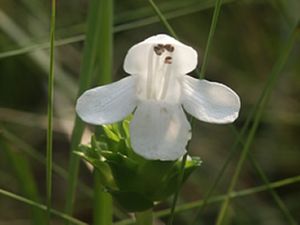White birds-in-a-nest facts for kids
Quick facts for kids White birds-in-a-nest |
|
|---|---|
 |
|
| Conservation status | |
| Scientific classification | |
| Genus: |
Macbridea
|
| Species: |
alba
|
The Macbridea alba is a special and rare flowering plant. It belongs to the mint family. People often call it the white birds-in-a-nest because of how its flowers look. This plant only grows in Florida in the United States. You can find it in just four counties in the Florida Panhandle. Sadly, its home is shrinking and getting damaged. Because of this, the United States government lists it as a threatened species. This means it needs protection to survive.
Contents
Where Does the White Birds-in-a-Nest Plant Live?
This unique mint plant grows in only a few places in Florida. You can find it in Gulf, Liberty, Franklin, and Bay counties. There are almost 10,000 of these plants in total. They live in several groups spread out across these areas. About 40% of these plant groups are found inside the Apalachicola National Forest. Sadly, some groups of these plants have completely disappeared from places where they used to grow.
What Does the White Birds-in-a-Nest Plant Look Like?
This plant is a type of herb that lives for many years. It usually grows one stem that is about 30 to 40 centimeters (12 to 16 inches) tall. The stem often has tiny, sticky hairs. Sometimes, the plant will have branches too.
Leaves and Flowers
The leaves grow in pairs along the stem. They are shaped like a spear or a spatula. Like the stem, the leaves can also be sticky. The flowers grow in a special cluster called an inflorescence. This cluster is full of green, pointed leaves called bracts. The flowers bloom right between these bracts.
Each flower has two lips and is white. It measures about 2.5 to 3 centimeters (about 1 inch) long. Sometimes, you might see light purple marks inside the flower. The way the open flowers and round buds sit among the green bracts makes them look like white birds and eggs in a nest. This is how the plant got its common name! The plant blooms from May through July. Bumblebees (Bombus species) likely help pollinate these flowers.
What Kind of Home Does This Plant Need?
The white birds-in-a-nest mint grows in specific wet areas. It likes pine flatwoods, wet seeps, and wet savannas. It also grows in the edges of swamps and sandhills. This plant prefers grassy spots with wet, poor soils. These soils are often sandy and have a lot of peat.
Threats to Its Home
The area where this plant lives, near the Apalachicola River Basin, has changed a lot because of people. In the past, some land was used for making paper pulp. Today, less land is used for this. Now, new homes and buildings are a big problem. As towns grow, roads and other services are built. Many of these plants grow along roadsides, making them vulnerable.
The Importance of Fire
The flatwoods where this plant lives need regular wildfires to stay healthy. Fire helps keep large trees and bushes from growing too tall. If these bigger plants grow too much, they block the sunlight from reaching the smaller plants below. But now, people often stop fires from burning. This prevents the natural fire cycle. When fires don't happen, the habitat changes and becomes less suitable for this mint and other small plants. Areas that haven't burned in many years have fewer of these mint plants. However, after a fire sweeps through, the plant often grows back strong. To help this plant, it's important to manage the land with controlled fires.
Images for kids



